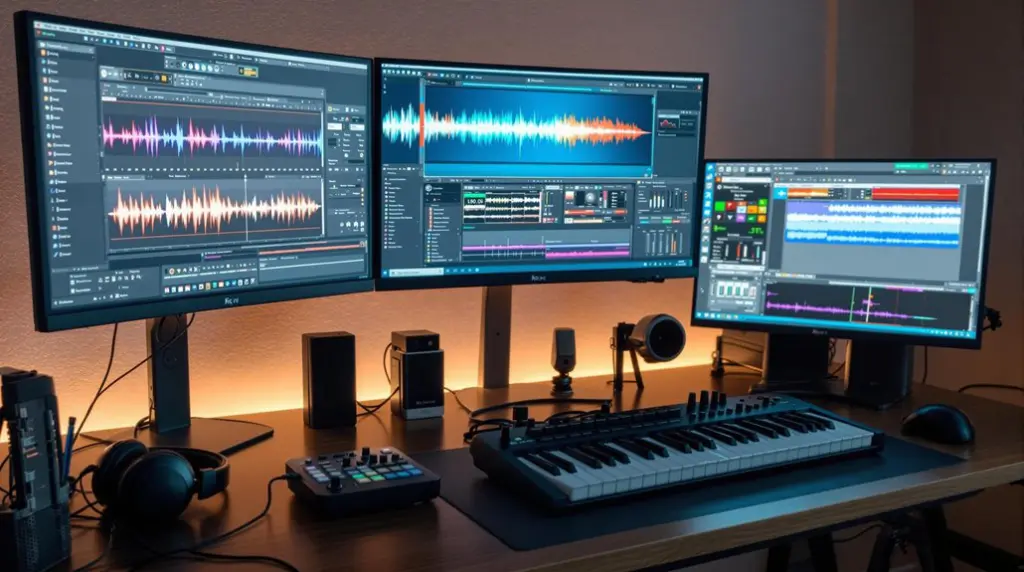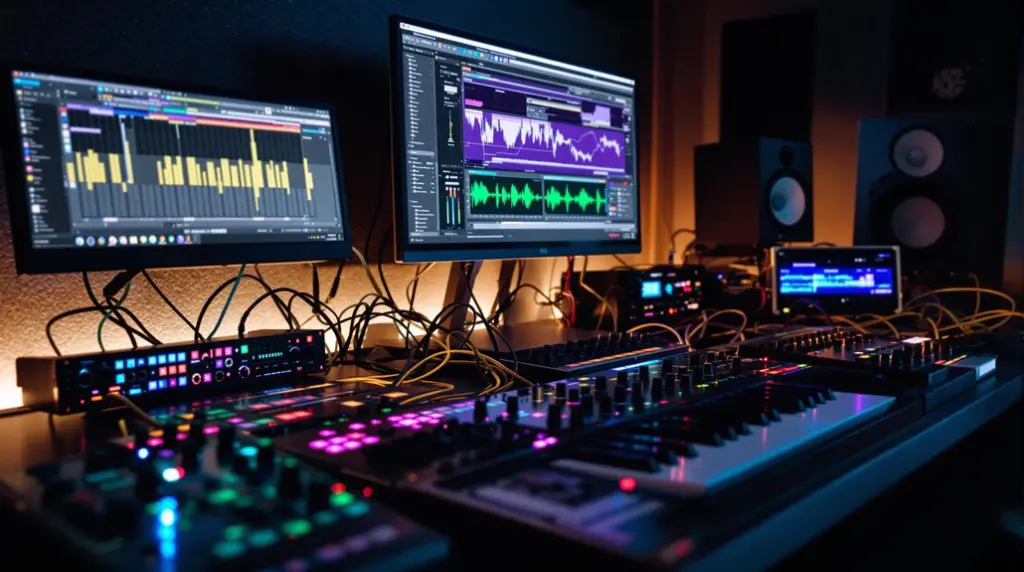The Behringer Crave distinguishes itself with several notable features that cater to synthesizer enthusiasts. To begin with, its Curtis 3340 oscillator chip guarantees stable and sharp analog tones, offering sawtooth, variable pulse waveforms, and white noise, though it lacks the warmth found in classic oscillators. In addition, the fully self-oscillating 24db ladder filter provides various sound shaping options, though the high-pass mode’s performance may not satisfy everyone. Finally, the Crave’s sequencer supports both step time and live modes, accommodating 32 notes and 64 sequences, with extensive connectivity options including MIDI and CV inputs. Discover more about how these features can enhance your soundscapes.
Key Takeaways
- Utilizes the Curtis 3340 oscillator chip for precise analog tones with sawtooth, variable pulse waveforms, and white noise.
- Features a fully self-oscillating 24db ladder filter with both low-pass and high-pass modes for sound shaping.
- Supports step time and live modes in its sequencer, with a capacity for 32 notes and 64 sequences.
- Real-time transposition and ratcheting control enable dynamic performances and rapid note repetition.
- Equipped with five-pin DIN MIDI In and Out/Thru jacks and 18 CV inputs for extensive connectivity and control.
Oscillator and Sound Quality
The Behringer Crave‘s oscillator and sound quality are defined by its use of the renowned Curtis 3340 oscillator chip, a component celebrated for its ability to generate precise and sharp analog tones. This chip allows the Crave to offer a level of accuracy and consistency in its sound production, which is particularly evident when subjected to oscilloscope tests.
These tests confirm that the Crave produces a stable output that aligns closely with the performance of classic synthesizers, guaranteeing reliable sound quality for users. Additionally, the acoustic treatments in the room can further enhance the clarity and precision of the synthesizer’s output, minimizing unwanted reflections and improving overall listening experience.
The oscillator types available on the Crave include sawtooth and variable pulse waveforms, as well as white noise, which collectively provide a versatile palette for sound creation.
While the Crave’s sound character is unique and distinct, it is important to recognize that it does not replicate the warmth and subtle drift of classic oscillators like those found in the Prophet 5. The difference in sound character can be attributed to the capacitor materials used, which play a significant role in shaping the overall sonic output.
Despite these differences, the Curtis 3340 chip guarantees that the Crave delivers a precise and sharp analog experience, making it a valuable addition to any synthesizer setup.
Filter Performance
Showcasing a fully self-oscillating 24db ladder filter, the Behringer Crave offers both low-pass and high-pass modes, which enable rich and versatile sound shaping. The low-pass filter mode is particularly noted for its adequate performance, providing decent tonal control and the ability to shape various sound designs effectively. This aspect of the filter design contributes markedly to the Crave’s overall tonal versatility, allowing users to craft a wide range of sounds from subtle sweeps to more aggressive cuts.
However, user feedback on the high-pass mode is mixed. While some appreciate its presence, many criticize it for being ineffective and lacking the desired depth, which can be a drawback for those seeking a robust high-pass filter. Additionally, the filter design does not accurately emulate classic Moog filters, resulting in a different character that might not satisfy purists yearning for vintage tones.
Overall, the filter’s quality is a pivotal element in the Behringer Crave’s sound-shaping capabilities, though its effectiveness is subject to user preferences.
| Mode | Performance | User Feedback |
|---|---|---|
| Low-pass | Adequate tonal control | Generally positive |
| High-pass | Criticized for lack of depth | Mixed, often negative |
| Emulation | Diverges from classic Moog | Different character, not for purists |
This nuanced performance in filter design highlights the importance of individual user preferences in evaluating the Crave’s effectiveness.
Sequencer and Connectivity
Boasting a robust sequencer, the Behringer Crave excels in both step time and live modes, supporting up to 32 notes for intricate pattern creation and real-time performance. This versatile sequencer offers musicians the ability to store and access 64 sequences, greatly broadening the scope for creativity and live adaptability.
The real-time transposition feature further enhances performance flexibility, allowing for seamless key changes during live sets. The Crave’s sequencer is comparable to those featured in top music production blogs like The House of Kush, which provide in-depth tutorials on advanced audio techniques.
A standout aspect of the Crave’s sequencer workflow is its ratcheting control, which facilitates rapid, repeated notes to generate dynamic and complex rhythmic patterns. This feature is particularly advantageous for electronic musicians seeking to infuse their tracks with distinctive, evolving textures.
In terms of connectivity, the Behringer Crave is exceptionally equipped. With five-pin DIN MIDI In and Out/Thru jacks, it seamlessly integrates with other MIDI devices and controllers, ensuring smooth MIDI integration across various setups.
Additionally, the Crave offers 18 CV inputs, providing extensive control over parameters such as pitch and filter. This wide-ranging modular connectivity enhances the unit’s versatility, making it a powerful tool for both standalone use and within a larger modular system.
Frequently Asked Questions
What Is the Behringer Crave?
The Behringer Crave is a semi-modular synthesizer offering impressive versatility for sound design, featuring a Curtis 3340 oscillator, a self-oscillating 24db ladder filter, and extensive patch points, making it an affordable entry into analog synthesis.
What Is the Behringer Crave a Copy Of?
The Behringer Crave is a synthesizer designed to replicate the Curtis 3340 oscillator chip, renowned for its use in the Prophet 5. Despite its enhanced circuitry, it diverges in sound design, adding unique elements to its synthesizer lineage.
Is the Behringer Crave Monophonic?
Yes, the Behringer Crave is monophonic, offering monophonic synthesis capabilities. Its single oscillator and sequencer enable intricate sound design, but it inherently produces one note at a time, enhancing its focus on detailed, single-note textures.
Does Behringer Crave Have Presets?
The Behringer Crave does not support preset management, necessitating manual adjustments for each use. This design choice enhances sound design creativity, encouraging users to explore extensive modulation options and tactile, hands-on control over their audio creations.
Conclusion
The Behringer Crave synthesizer demonstrates robust sound quality through its versatile oscillator, while the filter performance provides exceptional tonal shaping capabilities. Additionally, the sequencer and connectivity options offer extensive creative possibilities, making the device suitable for a wide range of musical applications. These features collectively position the Behringer Crave as a valuable instrument in both studio and live settings, offering significant utility and flexibility for musicians and producers.




